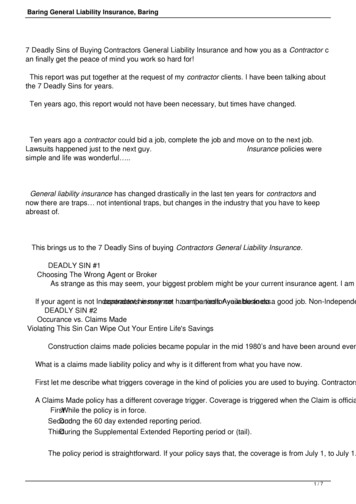
Transcription
First Edition7 Deadly Sins ofProject Management7PMA Project Smart Publication
Introduction
Section 1IntroductionWe all make mistakes. Project managers are certainly noexception - though as a profession we tend to be placed undermuch scrutiny at times and therefore those mistakes maybecome big news and can be - depending on the mistake quite damaging and costly to the projects we are running.In the world of project management, there are so many thingsthat need to be done and when they aren’t done, they candamage our project engagements. Or things that we do oractions that we actually do take, that can really mess things up,too. Sometimes we dip into our personal past or into ourprofessional past where we witnessed someone else’s projectgo south, to gain this type of insight. Either way, it makes animpression - likely because of the chaos and destruction itcaused on our projects.One way to look at it is consider what project management bestpractices are . and then not do them. Or take projectmanagement best practices and really screw them up and seewhat happens.As you read these pages, think about times when you’ve beenfaced with similar challenges and issues. How did you handlethem? Have you witnessed other project managers committhese sins? Is your organization committing them now - as awhole - because certain best practices aren’t part of yourPMO’s project management methodology or ongoing culture?2
Are you personally committing these on some or all of yourprojects currently? What other items might you consider to bedeadly sins or potential showstoppers on the path to projectsuccess?Let’s read on and consider each of these carefully - hopefullylearning along the way to avoid these mistakes or stop makingthem.whichever might happen to be your personal situation.3
Taking the Customer at TheirWord1
Taking the Customer atTheir WordLike most of us out there, I’ve learned some hard lessons in lifethrough relying on what normally would be common sense orcourtesy, only to find that others don’t have the sameunderstanding and they don’t always play by the same rules.Buying a house from unscrupulous realtors during the housingboom in Las Vegas was a learning experience, working in thecasino/gaming industry was sort of like Mr. Toad’s Wild Ride,and customer’s are not always fully educated on what theywant and need AND they’re usually looking out for their owninterests first.I’m not saying customers are bad – not by any means. But youperceive them to be the experts in what they want and needand that is often not the case. All they really truly know for sureis that they have a need – either because they’ve figured thatout for themselves or their end users have told them thatthrough feedback or declining sales, etc. You may also perceivethem to be fair, but again, they’re looking out for their ownfinancial needs first and that’s only fair. But whether you’re anindependent consultant going in to run an implementation for acustomer or you’re a project manager from a large organizationbacked by a PMO . either way don’t think the customer won’tleverage things their way whenever they feel they need to.What I’m saying is, don’t take anything with the customer forgranted.Don’t assume the customer understands their needGo into any engagement with the customer with the blinders off.Ask lots of questions, toss their ‘requirements’ aside or – if theylook halfway reasonable – use them.but only as a startingpoint. Never – under any circumstances – take customerprovided requirements and run with them without questioning5
them and drilling down deeper. It’s your job as the trainedprofessional to ask the tough questions and get to the realissue. Often, what the customer comes to you with is only asymptom of the real problem.Let’s say a project sponsor comes to you asking for new reportsto be created coming out of their timekeeping system becauseaccounting isn’t getting the information they need to do theirjob. If you ask enough questions and talk to the actual endusers, you may find that replacing the current timekeepingsystem with a newer one will give accounting their owninterface to get the info they need and allow for futureexpansion and scalability. Now you’ve solved today’s ANDtomorrow’s problems.questions and get to the heart of the issue. And all along, youhave to look out for your own interests as well. Carefully wordsignoff criteria and be sure to get official signoffs at all majormilestones in order to ensure that you get the milestone anddeliverable payments that are due to you and/or yourorganization.Don’t assume the customer has your backThe customer may be your friend during the engagement andthey may be as helpful as you can ever imagine a customerbeing. However, if things go wrong, they will cover their ownneeds. They will seek to replace team members on your projectteam by complaining to your senior management. And they will‘interpret’ signoffs to work in their favor as much as possibleand withhold payments until they are satisfied. Again, I am notsaying project customers are bad. They just have differentpriorities than we do and they have their own dollars andorganizations to protect.SummaryWithout customer there would be no projects. They can turn outto be our best friends.I stay in touch with many past clients allthe time. But you have to go into an engagement thinkingyou’re the expert and consider it a learning experience for youthat you have to make happen. You have to ask the right6
Leaving Your Success inManagement’s Hands2
Leaving Your Success inManagement’s HandsUnless you are working entirely as an independent contractoror have your own business, then you’re working for someone.And leaving your career entirely in someone else’s hands isnever a good idea. There are things you can’t help and youhave to rely on your direct supervisor for. And you definitelyneed to submit to authority. It’s part of your job, it’s the rightthing to do. But blindly following authority can have disastrousconsequences for you and sometimes your projects.I’ve found out the hard way on at least three occasions that mymanager did not have my best interests in mind when makingcertain decisions. One had a negative impact on my career withthe company I was working for, another had a negative impacton my working relationship with my direct supervisor and one ofmy employees, and the third ended up causing one of mycustomers to dump a project that I had been leading for nearlya year.I believe that our supervisors – for the most part – are trying todo what is right for the individuals they lead. just as we asproject managers try to do what is best for our project teammembers and our customers. However, they have manyobligations and constraints that they deal with every day. Andthey have responsibilities to their leadership which,unfortunately, can affect how they handle your needs and thedirection they give you and your teams.What I’m trying to say here is, we must take responsibility forand control of our own careers. When you think your bestinterests aren’t being served, you must be proactive. You mayeven need to go over your manager’s head. a practice thatyou don’t want to make a common occurrence if you hope tostay at your company very long. But if you’re convinced that theonly way you can make progress on a major project issue8
you’re experiencing is to go around your manager – do so.Ultimately, you’re serving your customer and you’ve beentasked to do this by your management and by the customer. Ifdecisions above you seem to be negatively impacting yourability to do your job, you must speak out. You must seekadditional help. You must go over someone’s head. To not dothat is deadly sin number #2.SummaryOnly we can look out for our own best interests. I am not sayingwe need to always act selfishly. In fact, I don’t believe that weever should really be acting selfishly. But we do need tomanage our own careers and assume that others may notalways be making the best decisions for what is happening onour projects and the tasks we are assigned to complete. Thebottom line – don’t blindly follow leadership. It’s ok to ask,“Why?”9
Trusting Team Members Without Question3
Trusting Team MembersWithout QuestionAnother mistake that we often make as project managers is toput too much trust in our project resource. Or maybe a betterway to say it is we give them too much leeway. And by that Imean taking their word for granted on whatever they tell us. Weknow they’re highly skilled resources – that’s why they’re on ourprojects. But as the project manager, it is always our job toquestion almost everything – whether it’s the customer, theproject team, or even sometimes our executive leadership, ifnecessary. The project is our baby and we must protect itssuccess potential as such.So what do we need to look out for from our project team?What do we need to question? In my experiences, here aresome of the areas, some are obvious, some may not be soobvious.EstimatesWhether it’s figures provided for tasks at the beginning of theproject or for change orders that occur during the project, theproject manager must question all estimates that come in tothem. Developers are notorious for padding numbers (I shouldknow, I used to be one of them) and the last thing you want todo is send a bloated development estimate off to a tech savvycustomer who calls you on it. For this very reason it’s best tohave tech savvy project managers running IT projects. Projectmanagers without a technical background are easily fooled bydevelopers when it comes to estimating timeframes and efforts.In fact, I usually estimate a change order myself and then run itby the developer to get their feedback. More than 90% of thetime I’m almost dead-on.11
Status updates and task progressSchedule conflictsI was going to split these two up, but they’re really one and thesame. When you get status updates or progress reports ontasks assigned to your team members, ask them questions. Apercent complete isn’t always going to tell you if there is anunderlying issue. Likewise, your team member may be the typethat doesn’t raise the red flag until the last second when it maybe too late to take corrective action. Ask plenty of questionsabout where things stand on the tasks your team members areassigned. The last thing you want is for the customer to askthose questions of the team member during a weekly status calland have them uncover an issue that you knew nothing about.If you’re a project manager running several projects at once,then it’s likely that your project team members are working onmore than one project at a time as well. Make sure you’re up tospeed on what other projects and tasks they’re assigned to. Belooking out for conflicts that can appear on the horizon. If aproject team member is working on another project that is morevisible than yours, know its status. Because if it runs intoproblems and your team member is critical to it, understand thatyou could lose this individual for a period of time. Keep that inmind as a risk as you address your project schedule on aweekly basis.Customer interactionSummaryYou may find that some of your project team members areinteracting with the customer on topics and tasks that you knewnothing about. You can’t let that happen – and if it does happenyou can’t let it continue. There are legitimate times when yourteam members must work directly with the customer, but youmust be aware of those efforts and be on top of the status at alltimes.We are usually blessed by being assigned the best individualsavailable for the projects we are running. I can say that I havepersonally enjoyed managing probably 98% of the resourcesthat I have had the pleasure of working with on the projects thatI have led over the years. But we must always manage aproject closely, track our team task assignments well, askquestions to ensure they have proper understanding and arestaying on track with their assignments, and hold themaccountable for what they are responsible for on our projects.The problem you can run into is that if you have a developerworking directly with a customer contact, subtle bells andwhistles get requested without your knowledge. The developer– with a big ego and confident that a little extra developmentwork costs nothing – can end up blowing your project budgetout of the water with extra work that the customer slips inbehind your back.12
Taking a Shortcut on Project Planning4
Taking a Shortcut onProject PlanningLike asking for directions on a long trip or reading directionsbefore putting something together, too many times our urge isto dive right in and “be productive” long before we are reallyready to do so. That is a mistake.and yes, a sin in the projectmanagement world. We – and our projects, customers, andteams - are far better off if we put enough time in the projectschedule to plan appropriately for the engagement we areabout to embark on. Few things can be more damaging to aproject so quickly than to not do an adequate job of upfrontplanning. And the problem here can be two-fold.Not planning enough before beginning the engagementSometimes your senior management wants a high-profileproject kicked off as quickly as possible. Maybe they’re gettingpressure from above. Possibly, they’re getting pressure fromthe customer. You may be even be getting direct pressure fromthe customer to get started on the engagement. There can beseveral ‘pulls’ that you’re getting that make it difficult to sit downand spend the proper time planning your project at thebeginning – before it’s even kicked off.This planning portion – that likely falls entirely to the projectmanager because in many organizations the full project teamhas not be assigned to the project yet – is critical because itinvolves getting handoff discussions and materials from Sales,creating an initial project schedule, putting together kickoffsession materials, fully understanding the statement of work(SOW), performing initial resource forecasting, and planning outthe project budget . just to name a few. If the project managerisn’t allowed enough time for this type of planning to take place,then the project will not be able to start off on the right foot andthe project manager will not be properly prepared to kickoff theproject and start managing the team, the budget, or even the14
customer without some degree of frustration anddisorganization.Not allowing for enough team/customer planning in theplanning phase of the project schedulethat is no way to manage a project or put our career on the rightpath. Customers may push back, executives may push back,but don’t be afraid to put your foot down and insist that the rightamount of time be spent properly defining requirements andplanning for the project engagement.The next type of planning concern involves creating enoughtime in the schedule as a placeholder for the planning phase ofthe project. This generally includes requirements definition andcreation of some sort of functional design document. These arecritical items – and I will say once again that requirements arethe lifeblood of the project. If the project manager attempts tomove the project into design and development phases withoutthe proper requirements definition attention then theengagement is likely headed toward scope issues that willundoubtedly affect the budget, the project timeline and mostdefinitely customer satisfaction.It is absolutely critical that enough time be set aside in theschedule for proper project planning and requirementsdefinition. Shout this one from the rooftops no matter who’spushing you to move forward more quickly. If it’s the customer,remind them how important their are and how quicklyproblems will arise if requirements aren’t properly documentedand agreed upon. If it’s your senior management, remind themhow quickly the customer will become dissatisfied and shutdown the project when the project goes way over budget or youhave to present change order after change order to them tocover all of the miscommunicated requirements. Customersatisfaction will take an enormous hit if this is allowed.SummaryFailure to plan really does planning to fail. Without properupfront planning, we are relying on luck to pull us through.and15
Getting Technically Out of Touch5
Getting Technically Out ofTouchI come from a technical background and the projects that I havemanaged have always been focused on some type of technicalsolution. I’ve long held that IT project managers need to cometo the position with some technical expertise in their past. Ifthey’ve been a developer or if they’ve held some position thatallows them to know their way around a technical solution it willlend that much more credibility to them with their customer andtheir project team.That said, in no way can past technical expertise carry youthrough for 20 years or more of project management withoutsome attempt to remain somewhat current on technology.Whether it’s trade magazines that you subscribe to, onlinearticles that you search through, conferences you attend, orcolleagues you network with, you must remain current if youhope to remain viable in leading successful technical projects. Ifyou are out of touch technically, you’re soon going to havetrouble connecting with your technical resources. They’ll loseconfidence in you, you won’t be able to adequately assess theirwork, confirm their estimates, and generally serve the bestneeds of your team and your customer. I’m not saying you’regoing to be an utter failure unless you are a technical expert,but you need to stay somewhat current. How do you do that?For me, I take three routes in working hard to remain currenttechnically so as to best serve my teams, my customer, and mycareer. I do this through.Conferences and seminarsI’ve been fortunate enough to attend thousands of dollars intechnical conferences for free this past year because I writetechnical articles. It’s a great way to seek out specific areas andattend sessions to gain further understanding. Not everyone17
can do that – and not everyone lives in Las Vegas where nearlyevery conference imaginable is held at some time or another.However, there is another way. I get at least 5-10 requestsevery week to sign up for some free seminar or webinar onlineon a specific area of technical expertise. Search the web – theyare out there. Be proactive . learn . take control.utilized on our project solution. And trust me, it is much easierto gain and keep the respect of your skilled technical resourcesif you have an understanding of what solution you areimplementing. I’ve witnessed the other side from watchingcolleagues who were out of touch technically.and it was not apretty sight.NetworkingNetworking online and at work with technical experts is a greatway to learn new things. Waiting till the last minute to get up tospeed for a specific project may lead to resentment among yourteam members, but asking them or their colleagues in advance– when things aren’t so critical – for help understanding a newtechnology or solution is a great way to learn. And they areoften more than happy to share their knowledge – it feeds theiregos.ReadingFinally, reading is probably my #1 way of staying current ontechnical issues. For me it’s a must because I’m also a projectmanager who writes a lot – and not just on PM issues. Soknowing things about where cloud computing is going, whatdisaster recovery topics are hot right now, etc. are important.But even if you’re just trying to get some new technicalknowledge for yourself – and not for what you’re writing about –reading your trade journals is still a great way to stay current.SummaryIt is our responsibility to remain current as much as possible. Asproject managers, we certainly do not need to be cutting edge –that is what our team is for. But we do need to have anunderstanding of what is going on and what technology is being18
Discounting Customer Satisfaction6
Discounting CustomerSatisfactionIn terms of the projects we manage, customer satisfaction isusually one of the three critical success measurements forengagements within an organization.What happens if we put too little stock in the customer’ssatisfaction level? I’m here to tell you that nothing good cancome of it. Certainly, you don’t do everything your customerasks. And certainly you don’t leave them unchecked to createhavoc on the project. As the project manager, you managethem. But you must understand their needs and tend to thoseneeds to the best of your ability. It is, after all, their money thatis paying for the project. And unless this customer is too painfulto ever work with again, it’s likely that you want to keep themaround as a repeat customer. And you certainly don’t want anybad press from this customer because they are dissatisfied,correct?So how do you ensure they are satisfied? You don’t. But youstick to the basics – good project management and goodcustomer management. Give them every reason to becomfortable with you and your team. Schedule your standardweekly project meetings and stick to the schedule. Deliverweekly status reports. Keep them appraised of issues, risks,and the project budget status. It’s the little communicationthings that we sometimes take for granted that can mean a lotto the customer. The difference between a customer who feelswell-informed and one who feels like they’re being kept in thedark is like night and day.One more thing you can do as the project manager to helpensure that customer satisfaction remains high is to get yoursenior management involved in the project. And I’m talking at avery high level. But if it’s a visible project with an importantcustomer (aren’t all customers important?) have someone high20
up in your organization sit in on a couple of project statusmeetings with the customer. When the customer feels like theirproject is important to you and your organization and they seethat portrayed by some senior management involvement, it canmake customer confidence and satisfaction soar.Try to put yourself in the client’s shoes and think about how youwould want to be treated and what information you would wantto see on a weekly basis for all the money you’re spending.Then go out and meet those needs. What happens next maysurprise you.SummaryNothing can guarantee project success. However, sticking toproject management best practices, keeping the customer wellinformed throughout the engagement, and working hard everystep of the way to ensure that your customer remains wellengaged on a weekly basis will go a long way in ensuring thatyou continue to have a highly satisfied customer. That andmaking sure you deliver a workable end solution that their userscan actually use.21
Not Emphasizing Communication Enough7
Not EmphasizingCommunication EnoughWhen the project manager considers communication as justanother soft tool, they run the risk of having everything fall apartaround them at any given time. In my opinion, the ability toeffectively and efficiently communicate with your project team,your customer, your senior management and anyone else youinteract with while running your projects is the #1 skill you bringto the table as a project manager. There are some things youcan fake or skate along without till you gain experience andacquire more skills. Communication is not one of them. Toomany things on the project rely on good, solid communication: Effective leadership Customer satisfaction Project team understanding Senior management confidence and buy-in Cohesive team performance throughout theengagement Customer participation Etc. . the list could go on and on.So practicing effective communication on the project is not justa ‘nice to have’ . it’s a ‘gotta have.’ And to me, being aneffective communicator as a project manager involves thefollowing:Consistently communicating project statusProject status reports and project status meetings are moreimportant to your customer than you realize. They are far moreimportant that receiving an electronic copy of the revised23
project schedule. Even if you really don’t have much in the wayof new information in a given week, still hold the meeting. Yourcustomer loves consistency – and it certainly breedsconfidence. Canceling a meeting makes it easy for teammembers to get out of sync. Soon you’ll find it hard to getpeople together for meetings because they are expecting you tocancel them. And get the status report out consistently everyweek – a day ahead of the weekly status call so that everyonehas a chance to review it and get you an update if they see anerror or omission.Monitoring all major project communicationsStarting with the development of a Project CommunicationPlan, the project manager must lay the groundwork for howcommunication is going to happen throughout the engagement.There needs to be a clear understanding that all importantcommunication is funneled through the project manager andthe team and the customer need to understand what types offormal communication will take place on the project and when.This ‘formal’ communication involves project status reports,project status meetings, adhoc status calls, internal projectteam meetings, quarterly and phase project meetings, etc. Thatall needs to be addressed in a plan that is documented andsigned off – and followed throughout the project. You’ll besurprised how much customer confidence and satisfaction isrealized when they are comfortable that all participants are wellinformed and that you’re on top of all-important communication.other project managers they work with. They’ll feel like they areon top of status – because they are.For your customer, keep them informed, but you don’t need togive them every internal detail. Give them the important stuff.Too much of the daily detail leads to confusion and maydecrease confidence when it shouldn’t. Don’t withhold importantinformation, but they don’t need to or want to hear every detail.SummaryNever take project communication for granted. A formalcommunication plan may be overkill if your project is very smallor very short.or both. But it will never hurt to have one and canprovide your customer with a great deal of confidence that youare being highly accountable in terms of project communication.Communication is the single most important skill that the projectmanager can bring to the table, in my opinion. A well-informedcustomer will stay engaged. A well-informed team will remainaccountable. A well-informed executive management staff willlet you do your job.Encouraging a cohesive communication environmentThis one is important. For your team, it involves having weeklyinternal team meetings and disseminating all important projectinfo to the team quickly – like through an email list. Be theproject manager who sends your team more emails than the24
About the AuthorBrad Egeland is a Business Solution Designer and an InformationTechnology / Project Management consultant and author with over 25years of software development, management, and project managementexperience. He has successfully led project initiatives in Manufacturing,Government Contracting, Creative Design, Gaming and Hospitality,Retail Operations, Aviation and Airline, Pharmaceutical, Start-ups,Healthcare, Higher Education, Non-profit, High-Tech, Engineering andgeneral IT.In addition to his accomplishments in IT development, resource, andproject management, he has also authored close to 3,000 expert adviceand strategy articles on project management, small business, andinformation technology for his own website as well as sites and printedmaterial for software and service clients all over the world. Brad is highlyregarded as one of the most prolific go-to authors on projectmanagement general topics, advice and strategy in the world. He oftenbases his articles on his own personal experiences, successes andfrustrations, providing insights on how to combat issues and deficienciesencountered along the way to the average project manager, businessowner or strategist looking for help in a given situation.Brad is married, a father of 10, and living in sunny Las Vegas, NV. Youcan learn more about Brad or contact him through the following:LinkedIn: http://www.linkedin.com/in/bradegelandEmail: brad@bradegeland.comxxv
About Project SmartProject Smart is the project management resource that helps managersat all levels improve their performance. We provide an importantknowledge base for those involved in managing projects of all kinds.More information about project management can be found on ourwebsite www.projectsmart.co.ukxxvi
CopyrightCopyright 2014 by Project Smart. All rights reserved.No part of this publication may be reproduced or transmitted in any form,by any means, electronic, photocopying, scanning, recording orotherwise, without the prior written consent of Project Smart.xxvii
7 Deadly Sins of Project Management PM7. Introduction. 2 We all make mistakes. Project managers are certainly no exception - though as a profession we tend to be placed under much scrutiny at times and therefore those mistakes may become big news and can be - depending on the mistake -










